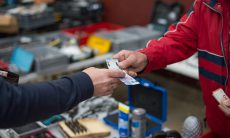Big Data is a broad term for data sets so large or complex that traditional data processing applications are inadequate. Challenges include analysis, capture, data curation, search, sharing, storage, transfer, visualization, and information privacy.
Big Data is also a big investment for a company involving software, manpower and new processes. But data, big or little, seems to be moving up the agenda in many companies as a priority to create better outcomes that increase success.
- 91% of marketing leaders believe successful brands use customer data to drive business decisions (source: BRITE/NYAMA)
- 87% agree capturing and sharing the right data is important to effectively measuring ROI in their own company (BRITE/NYAMA)
- 86% of people are willing to pay more for a great customer experience with a brand (souce: Lunch Pail)
So what companies are making it happen? And how? Here are 16 case studies of companies proving ROI of Big Data.
- AETNA: Looks at patient results on a series of metabolic syndrome-detecting tests, assesses patient risk factors, and focuses on treating one or two things that will have the most impact (statistically speaking) on improving their health. 90% of patients who didn’t have a previous visit with their doctor would benefit from a screening, and 60% would benefit from improving their adherence to their medicine regimen.
- AMERICAN EXPRESS: Starts looking for indicators that could really predict loyalty and developed sophisticated predictive models to analyze historical transactions and 115 variables to forecast potential churn. The company believes it can now identify 24% of accounts that will close within the next four months.
- DELTA: With over 130 million bags checked per year, Delta has a lot of tracking data about bags and became the first major airline to allow customers to track their bags from mobile devices. To date, the app has been downloaded over 11 million times and gives customers much greater peace of mind.
- EVOVL: Helps large global companies make better hiring and management decisions through the use of predictive analytics. Evolv crunches more than 500 million data points on gas prices, unemployment rates, and social media usage to help clients like Xerox—who has cut attrition by 20 percent—predict, for example, when an employee is most likely to leave his/her job. Companies like Xerox, AT&T, and Kelly Services use Evolv, and on average, our clients see a $10 million impact on their P&L. Evolv’s sales grew a whopping 150% from Q3 2012 to Q3 2013.
- GENERAL ELECTRIC (GE): Many machines—everything from power plants to locomotives to hospital equipment—now pump out data about how they’re operating. GE’s analytics team crunches it, then rejiggers machines to be more efficient. Even tiny improvements are substantial, given the scale: by GE’s estimates, data can boost productivity in the U.S. by 1.5%, which over a 20-year period could save enough cash to raise average national incomes by as much as 30%.
- IRS: Uses Big Data to to stop identity theft, fraud, and improper payments, such as those who are not paying taxes, but should be. The system also helps to ensure compliance with tax rules and laws. So far, the IRS has stopped billions of dollars in fraud, specifically with identity theft, and recovered more than $2 billion over the last three years.
- KAISER: Uses Big Data to study the incidence of blood clots within a group of women taking oral contraceptives. The analysis revealed that one formula contained a drug that increased the threat of blood clots by 77%—understanding these types of patterns can help many people avoid visits to the doctor or emergency room.
- KROGER: Accesses, collects, and manages data for about 770 million consumers. Claiming 95% of sales are rung up on the loyalty card, Kroger sees an impact from its award-winning loyalty program through nearly 60% redemption rates and over $12 billion in incremental revenue by using big data and analytics.
- PROCTER & GAMBLE: Examines its business program success and react more quickly to changing market conditions. P&G needed to clearly and easily understand its rapidly growing and vast amount of data, integrated vast amounts of structured and unstructured data across research and development, supply chain, customer-facing operations, and customer interactions, both from traditional data sources and new sources of online data. Now, P&G can load and integrate data faster and execute reliable analysis at scales that were previously not possible.
- RED ROOF INN: Produces 10% growth year over year helping people who are stranded due to bad weather. The marketing department uses historical weather information, and began a plan to target stranded airport passengers. With an estimated 2-3% of flights cancelled daily, 500 planes don’t take off, 90,000 passengers get stranded. The company uses Big Data to identify the areas of demand and uses search advertising, a focus on mobile communications, and other methods to drive digital bookings with personalized messages like ‘Stranded at O’Hare? Check out Red Roof Inn.’
- SPRINT: Uses Big Data analytics to improve quality and customer experience while reducing network error rates and customer churn. They handle tens of billions of transactions per day for 53 million users, and their Big Data analytics put real-time intelligence into the network, driving a 90% increase in capacity.
- THE WEATHER CHANNEL: Is more than just a weather channel. By analyzing the behavior patterns of its digital and mobile users in 3 million locations worldwide—along with the unique climate data in each locale—the Weather Company has become an advertising powerhouse, letting shampoo brands, for example, target users in a humid climate with a new anti-frizz product. More than half of the Weather Company’s ad revenue is now generated from its digital operations.
- T-MOBILE: Has integrated Big Data across multiple IT systems to combine customer transaction and interactions data in order to better predict customer defections. By leveraging social media data (Big Data) along with transaction data from CRM and Billing systems, T-Mobile USA has been able to “cut customer defections in half in a single quarter.”
- UPS: On a daily basis, UPS makes 16.9 package and document deliveries every day and over 4 billion items shipped per year through almost 100,000 vehicles. With this volume, there are numerous ways UPS uses big data, and one of the applications is for fleet optimization. On-truck telematics and advanced algorithms help with routes, engine idle time, and predictive maintenance. Since starting the program, the company has saved over 39 million gallons of fuel and avoided driving 364 million miles.
- US XPRESS: A provider of a wide variety of transportation solutions collects about a thousand data elements ranging from fuel usage, to tire condition, to truck engine operations, to GPS information, and uses this data for optimal fleet management and to drive productivity, saving millions of dollars in operating costs.
- WAL-MART: Relies on text analysis, machine learning, and even synonym mining to produce relevant search results. Wal-Mart says adding semantic search has improved online shoppers completing a purchase by 10% to 15%. In Wal-Mart terms, that is billions of dollars.
Do these case studies convince you of the ROI of Big Data? Do these give you any ideas? Do you need help proving the ROI of Big Data at your companies?







